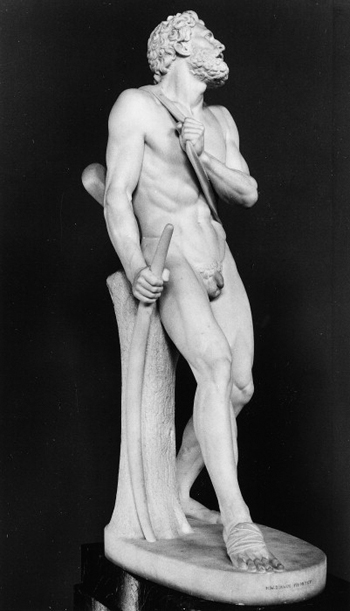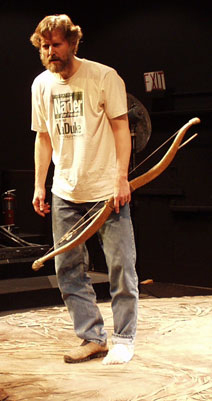I spent this past August soaking in the spectacle of the Athens Olympics. From director Dimitris Papaioannou’s opening ceremonies (very Robert Wilson), to the poetry of shot putters at Olympus; the palpable history and pageantry were at times overwhelming and inspiring. We found ourselves frequenting Greek restaurants, searching out Greek wines, and seeing the world through Greek mythology.
Rather than searching for equivalents between Mt. Olympus and design history, I became temporarily obsessed with a particular character from Greek mythology: the archer Philoctetes.

Many contemporary folks were probably introduced to Philoctetes (fi-lok-tee-teez) through American critic Edmund Wilson and his essay The Wound and the Bow — but I’m getting ahead of myself. First, some rushed descriptions and over-simplifications:
Different versions and interpretations of the myth describe Philoctetes as either a follower or lover of Hercules; who inherited an unerring bow and arrows as reward for lighting the hero’s funeral pyre. On the way to the Trojan War, he accidentally stepped off a path leading to a shrine, onto sacred ground and was bitten on the foot by a protecting serpent. Being a devine punishment, the wound didn’t heal and turned into a stinking, festering pus hole. The stench, plus his constant screams of agony, were too much for his traveling companions (led by Odysseus/Ulysses) and he was stranded on the island of Lemnos.
Sophocles’ Philoctetes begins ten years later with Odysseus back on Lemnos, searching for the archer. The war has dragged on too savagely long, and the Greeks had been told by a seer that only Hercules’ bow and arrows could defeat the Trojans. Odysseus sends Neoptolemus to deceive Philoctetes into joining them with an empty promise of a journey home. Neoptolemus also tries the old “why don’t you let me hold on to your bow and arrows for you” deception.
Long story short, Neoptolemus finally tells Philoctetes the truth, abandonment issues are resolved, and they all set sail for Troy. The myths further describe the healing of Philoctetes’ wound and how he kills Paris, setting the stage for the fall of Troy with the Trojan Horse.
It was Wilson’s essay that first drew the metaphorical comparison between Philoctetes, the artist, and their mutual separation from society. It described the figure of the indispensable sufferer; and explored how Philoctetes’ wound gave him a certain nobility — a sort of character building through suffering. Wilson wasn’t the first to mine the dichotomy of illness/strength or trauma/art. These are old standards in the history of art: Charlie Parker, Borges, Toulouse-Lautrec… As are the ‘fish out of water’ variations caused by differences of language, gender, culture, etc.: Nabokov, James Baldwin, Billy Strayhorn, Rimbaud…
But what drew my interest were mundane trivia, like how ‘Philoctetes’ translates as ‘lover of things’; the easy metaphor of the Greeks’ initial attempts to get the computer bow, but not the designer archer; or the melodramatic metaphor of the most capable person being the least wanted.

…then I began to think about all the neurotic hand-wringing over how designers want to be involved earlier in business planning. And you know what? Maybe that’s the last thing we should have. Because at that moment, we lose part of our desire and the ‘otherness’ that makes us so unique. Disappointment can be a great source for creativity. And perhaps if more designers ever found themselves better positioned in the hierarchy of American business, we would have to create another issue to carp about.
So for now, let’s learn to cherish our position in the great myth.
In the words of a certain television show, “…be seeing you.”







So for now, let’s learn to cherish our position in the great myth.
If not now, then when? And why not now to make planned progress for greater respect and influence?
Have too many designers tried for the seat and not made it? Is there always the glass ceiling Rob Bennett refers to? I don't think there is.
As a young designer in an environment that supports my ambitions, I wonder if this optimism and confidence is only mine. I've experienced the pieces working in isolation. I've seen them working together, in practice in books, business news, and this site itself. The emerging individuals that will be most successful and influential in this discipline are those that will learn from the success and failures of similar endeavors is the recent past and formulate new ways of selling their own ability to fill an influential role.
I must admit, that cherish is the least hostile of terms with which to find contentment in stasis. If the proposition is for all of us to join in and be satisfied with the current state of a designer in the business hierarchy, then on behalf of at least myself, I respectfully decline the invitation.
Am I just an idealist? I'd like to think its closer to an optimistic and opportunistic realist. Am I strategic business planner with an acute understanding of the value of design? Perhaps...
I was attracted to and began to understand design for its aesthetic qualities, later becoming seduced by its power and widespread influence. Design is romantic. Visual and experiential beauty is fulfilling for both viewer and creator. I am certain it is not only admirable but completely feasible to inspire and shape an approach to design that begins at "the table," fusing strategic business thinking with the process and art of designing. More than feasible, it is necessary.
I am certainly not a Greek hero or an Olympian, but I train for this day in and day out (and night in and night out). I condition myself and my performance to reach an end that only the best trained might reach.
While I appreciate (read: cherish) and respect where I have been and where I am going, I look up and forward for possibilities yet unexplored.
The designer in a respected seat at the table is every bit as beautiful as Bannister's Four-Minute Mile and Papaioannou's Eros.
Right now, let's learn to define our position in the current-turn-future reality.
On Sep.06.2004 at 06:28 PM